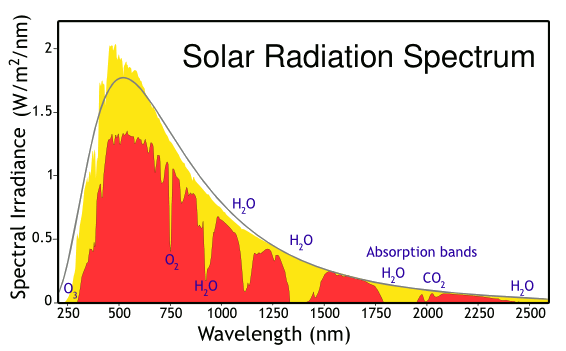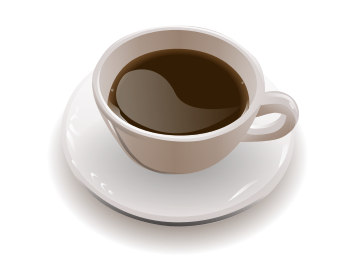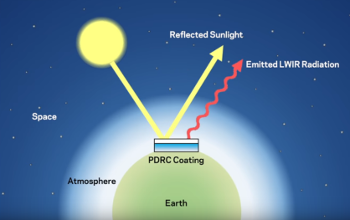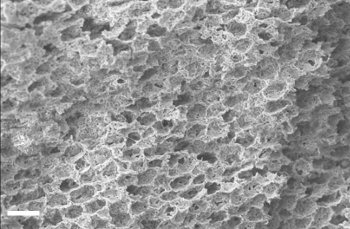Solar Reflecting Paint
November 19, 2018
From an early age,
children learn that
white objects remain
cooler in
sunlight than
darker objects; so, it's "obvious" that a person should wear white
clothing in
summer, and dark clothing in the
winter.
Thermodynamics, however, brings some surprises when we go beyond a
spherical cow model to something more complete. On closer examination, it appears that the
exhortation to wear white between
Memorial Day and
Labor Day is more of a
fashion statement than
advice for keeping yourself comfortable, at least when a
breeze is blowing.
Animals often act as
surrogates in
experiments to determine to what might be expected for
humans. Research on
bird plumage by
scientists at the
University of Arizona (Tucson, Arizona), and
Arizona State University (Tempe, Arizona), showed that fluffy black
feathers are better than white feathers for removal of
heat from a
bird's body when there's a breeze.[1]
Extrapolating this finding to clothing indicates that wearing loose-fitting black clothing in the heat is potentially better than wearing white, as long as the air is not still.
One
material that's most certainly black is
carbon soot, and this fact has an important
environmental aspect.
Atmospheric carbon soot, also known as
black carbon, is generated by
combustion, and it's a significant contributor to
global warming. The
insolation received from the
Sun comes not just in the
visible light spectrum, but in
wavelengths far out in the
infrared, and carbon soot is effectively black at all these wavelengths. Reduction in the production of black carbon might be one way of slowing global warming. I wrote about black carbon in an
earlier article (Paint it Black, February 13, 2013).

Solar energy incident at Earth's atmosphere and Earth's surface. The yellow curve is the radiation incident at the top of the atmosphere, while the red curve is the radiation at Earth's surface, diminished by the atmospheric absorbers shown. The radiation approximates a blackbody curve for 5250 kelvin. These data are from the American Society for Testing and Materials (ASTM) Terrestrial Reference Spectra, which is used as a test condition for solar panels in North America. (Modified image from Wikimedia Commons.)
The difference of
thermal properties between black and white materials has led to some interesting conversations among scientists. As
mathematician,
Alfréd Rényi (1921-1970), noted,
a mathematician is a machine for turning coffee into theorems. Scientists are good at transforming
coffee into useful
research, some of which is on coffee itself. The cooling rate of
coffee should be different when the coffee is black and when it's whitened with added
milk or
cream. Cooling of a
liquid like coffee involves quite a few
thermodynamic processes that include
thermal radiation,
heat conduction, heat loss by
evaporation, and
thermal convection. I wrote about coffee thermodynamics in an
earlier article (Coffee Thermodynamics, June 17, 2011).
The general problem for people who enjoy cream in their coffee is whether they should add the cream immediately, or wait a minute or two if they want to bring their coffee quickly to a
drinkable temperature. Just considering thermal radiation, keeping the coffee black longer would be the best
strategy, but removal of heat by radiation at coffee temperatures is not that important.
Conduction dominates, so liquids with a higher differential temperature with respect to
ambient will cool faster, and this would be the reason for keeping the coffee black for a longer time.
Of course,
the devil is in the details, and the
fat content in cream will likely reduce
convection in the hot liquid, keeping it hot for a longer time. Added cream will also reduce the evaporative cooling, so my opinion on the matter is that coffee should cool faster when the cream is added later. This is definitely a case where one good experiment is better than a lot of
theory. This problem has been examined by many, and it does appear that keeping the coffee black longer does lead to a cooler final liquid.[2-4] Specifically, waiting 310 seconds to add milk brought coffee to a safe drinking temperature 85
seconds faster.[4] The affect of evaporation is quite large, since a cup of water with a lid cooled about 36
°C in one hour, and without the lid, about 53°C in an hour.[4]

World coffee production was nearly 10 million tons in 2016, about a third of which was produced in Brazil.
As cited on the Wikipedia coffee page, many studies have associated coffee drinking with a significantly reduced risk of death from disease.
(Wikimedia Commons image.)
My first
automobile was white, a color choice motivated more by the
price of this
used car and my
student budget than thermodynamics. My current automobile is not white, but it's a light color, a choice that's vindicated by a scientific study by researchers at
Lawrence Berkeley National Laboratory of how automobile color affects the interior temperature and the
energy requirement for
air conditioning.[5-6] The research was supported by the
California Energy Commission and the
U.S. Department of Energy.[6]
The color effect on automobile temperature is quite large. Experiments with two nearly identical
Honda Civic four-door sedans,one
silver color (solar reflectance =0.58), and the other black (solar reflectance = 0.05), the silver automobile had a 5-6°C lower interior air temperature. An analysis predicted that the air conditioning requirement for the silver automobile was 13% less to bring the interior air temperature to 25°C.[5] The
roof of the silver automobile was as much as 25°C (45°F) cooler than the roof on the black automobile.[6] A light
paint with a solar reflectance of a smaller 0.35 would increase
fuel economy by 0.24
miles per
gallons, or 1.1%, and would reduce
emissions.[6]
Says
Ronnen Levinson, lead
author of the LBNL study,
"Solar reflective paints can decrease the 'soak' temperature of the air in a car that has been parked in the sun... This could improve the vehicle's fuel economy by letting the manufacturer install a smaller air conditioner that draws less power from the engine. White, silver, and other light colors are coolest, reflecting about 60 percent of sunlight. However, the study showed that dark cool colors, which reflect primarily in the invisible near-infrared part of the solar spectrum, can also stay cooler than traditional dark colors.[6]
Reflecting 50% of the sun's rays from painted surfaces of an automobile does have a beneficial effect, but automobiles have a lot of
glass and a considerable
vertical surface area, so I wouldn't put much more effort into such research over other paths to fuel efficiency, especially in the cooler
Northern latitudes. A better reflective paint would be beneficial, however, when it coats entire
buildings, but do we want our world to be uniformly white? That would be hard on the
eyes. A team of scientists from
Columbia University (New York, New York) and
Argonne National Laboratory (Lemony, Illinois) have developed a
mircostructured polymer coating that acts as a spontaneous air cooler and can be
dyed different colors.[7-9] Their research is reported in an
open-access article in
Science.[8]
The polymer coating uses a principle called
passive daytime radiative cooling (PDRC) in which a surface remains cool by the double process of reflecting sunlight and also radiating heat to the colder atmosphere (see figure). PDRC functions best when a surface has a high solar reflectance and a high
thermal emittance.[8] Surfaces that are
pigmented white still absorb parts of the solar spectrum, notably in the
ultraviolet. The polymer coating has
nanoscale to microscale air
voids that scatter and reflect sunlight.[7-8] The reflectance arises from the difference in
refractive index between the air voids and the polymer, and the intrinsic emittance of the polymer allows
efficient heat radiation.[8]

passive daytime radiative cooling (PRDC) concept.
The PRDC material has both high reflectance to prevent heating by insolation, and high thermal emittance to remove heat by radiation.
(Still image from a YouTube video by Columbia University.[9])
The
hierarchically porous polyvinylidene fluoride-co-
hexafluoropropene (p(VdF-HFP)HP) coatings with light
scattering air-voids were created by the simple,
solution-based method of
phase-inversion.[7-8] A solution of P(VdF-HFP) was mixed with
water (an
immicible non-
solvent) and
acetone (solvent), applied as a coating onto a
substrate, and dried in air. The rapid evaporation of acetone causes the p(VdF-HFP) to phase-separate from the water to form micro- and nano-
droplets. The resultant micro- and nano-pores efficiently scatter sunlight and enhance thermal emittance. The final films have about 50% porosity, a 0.96 ± 0.03 % reflectance and a
long-wave infrared (LWIR) emittance of 0.97 ± 0.02.[7]

Scanning electron micrograph of the passive daytime radiative cooling coating.
The scale bar is 10 micrometers.
(Still image from a YouTube video by Columbia University.[9])
The high solar reflectance and long-wave infrared emittance results in a temperature drop of of about 6°C at an insolation of 890
W/m2.[7] The polymer coating gave a 6°C cooler surface in the
warm, arid climate of
Arizona, and 3°C cooler surface in the
foggy,
tropical environment of
Bangladesh.[8] The coating can be effectively dyed. Says
Nanfang Yu, an
associate professor of
applied physics and a study author,
"Achieving a superior balance between color and cooling performance over current paints is one of the most important aspects of our work... For exterior coatings, the choice of color is often subjective, and paint manufacturers have been trying to make colored coatings, like those for roofs, for decades."[8]

Visible (left) and infrared (right) images of the PRDC coating in sunlight. In the infrared image, darker colors are cooler. (Right image and left image by Jyotirmoy Mandal/Columbia Engineering.)
References:
- Blair O. Wolf and Glenn E. Walsberg, "The Role of the Plumage in Heat Transfer Processes of Birds," Integrative and Comparative Biology, vol. 40, no. 4 (August 1, 2000), pp. 575-584, https://doi.org/10.1093/icb/40.4.575.
- S. M. Blinder, "The Coffee Cooling Problem," Wolfram Demonstrations.
- W. G. Rees and C. Viney, "On Cooling Tea and Coffee," American Journal of Physics, vol. 56, no. 5 (July 28, 1998), pp. 434-437, https://doi.org/10.1119/1.15572.
- Darwin Novak and Robert Seidel "The Mechanisms of Cooling Hot Quiescent Liquids," American Institute of Chemical Engineers Conference (Philadelphia, Pennsylvania, 1958), apparently unpublished, but cited in Joseph Weeks, "When hands are around a hot drink do they insulate it or cool it?" MadSci.org, November 12, 2004.
- Ronnen Levinson, Heng Pan, George Ban-Weiss, Pablo Rosado, Riccardo Paolini, and Hashem Akbari, "Potential benefits of solar reflective car shells: Cooler cabins, fuel savings and emission reductions," Applied Energy, vol. 88, no. 12 (December 2011), pp. 4343-4357 https://doi.org/10.1016/j.apenergy.2011.05.006.
- Allen Chen, "Cool Car Colors Could Improve Fuel Economy, Reduce Emissions," Lawrence Berkeley Laboratory EETD News #37 Vol. 10, No. 2 (Fall 2011). PDF File.
- J. Mandal, Y. Fu, A. Overvig, M. Jia, K. Sun, N. Shi, H. Zhou, X. Xiao, N. Yu, and Y. Yang, "Hierarchically porous polymer coatings for highly efficient passive daytime radiative cooling," Science, Article no. eaat9513 (Early Edition, September 27, 2018), DOI: 10.1126/science.aat9513. This is an open access article with a PDF file here.
- Holly Evarts, "Polymer Coating Cools Down Buildings, Columbia University Press Release,September 27, 2018.
- Making Paints Whiter and Cooler, Columbia Engineering YouTube Video, September 27, 2018.
Linked Keywords: Child; children; white; temperature; cool; sunlight; albedo; dark; clothing; summer; winter; thermodynamics; spherical cow model; exhortation; Memorial Day; Labor Day; fashion statement; advice (opinion); wind; breeze; animal; surrogate; experiment; human; bird plumage; scientist; University of Arizona (Tucson, Arizona); Arizona State University (Tempe, Arizona); feather; heat; bird; extrapolation; extrapolating; material; carbon; soot; environment; environmental; atmosphere of Earth; atmospheric; black carbon; combustion; global warming; insolation; Sun; visible light spectrum; wavelength; infrared; solar energy; lithosphere; Earth's surface; radiation; greenhouse gas; atmospheric absorbers; blackbody curve; kelvin; American Society for Testing and Materials; solar panel; North America; Wikimedia Commons; temperature; thermal; mathematician; Alfréd Rényi (1921-1970); a mathematician is a machine for turning coffee into theorems; coffee; research; milk; cream; liquid; thermodynamic process; thermal radiation; heat conduction; evaporation; thermal convection; drinking; drinkable; strategy; room temperature; ambient; the devil is in the details; fat; theory; second; Celsius; °C; coffee production; tonne; ton; Brazil; Wikipedia coffee page; mortality rate; reduced risk of death; disease; car; automobile; price; used car; undergraduate education; student; budget; Lawrence Berkeley National Laboratory; energy; air conditioning; California Energy Commission; U.S. Department of Energy; Honda Civic four-door sedan; silver color; roof; paint; fuel economy; mile; gallon; exhaust gas; emission; Ronnen Levinson; author; manufacturing; manufacturer; engine power; glass; vertical; surface area; 42nd parallel north; Northern latitude; building; eye; Columbia University (New York, New York); Argonne National Laboratory (Lemony, Illinois); microstructure; mircostructured; polymer; coating; dye; dyed; open-access journal; open-access article; Science; radiative cooling; passive daytime radiative cooling; thermal emittance; pigment; pigmented; ultraviolet; nanoscopic scale; nanoscale to microscale; void; refractive index; efficiency; efficient; material; reflection; reflectance; YouTube video; hierarchy; hierarchical; porosity; porous; polyvinylidene fluoride; hexafluoropropene; scattering; solution; phase inversion (chemistry); water; miscibility; immicible; solvent; acetone; substrate; drop; droplet; long-wave infrared; scanning electron micrograph; linear scale; scale bar; micrometer; surface power density; W/m2; desert climate; warm, arid climate; Arizona; fog; foggy; tropics; tropical; Bangladesh; Nanfang Yu; associate professor; applied physics; subjectivity; subjective; decade; visible spectrum; digital image.